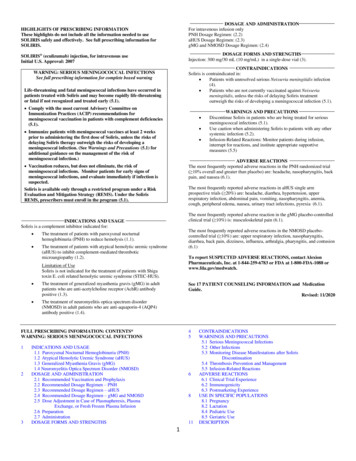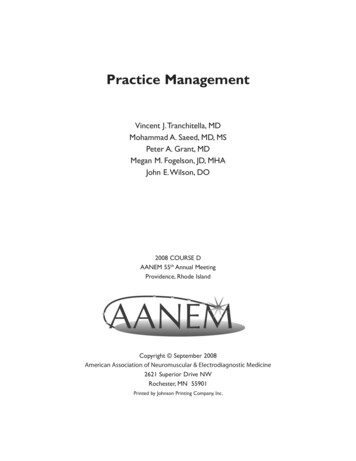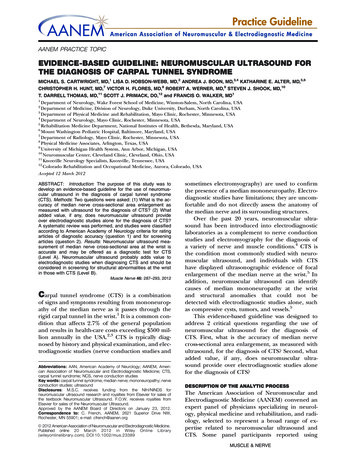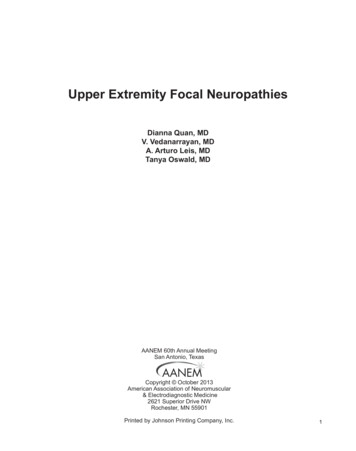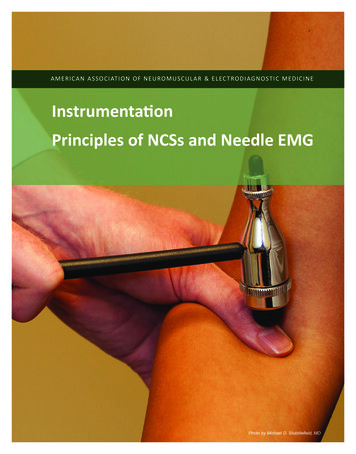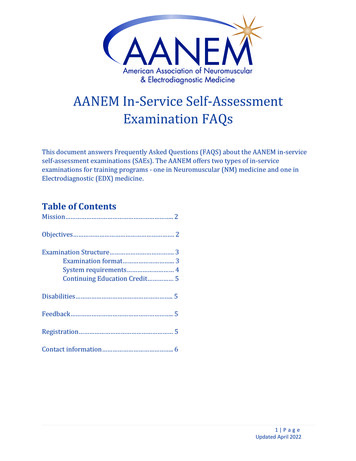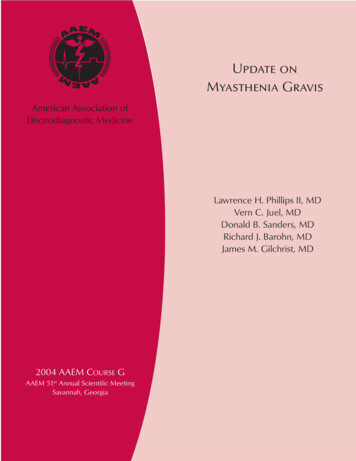
Transcription
Update onMyasthenia GravisAmerican Association ofElectrodiagnostic MedicineLawrence H. Phillips II, MDVern C. Juel, MDDonald B. Sanders, MDRichard J. Barohn, MDJames M. Gilchrist, MD2004 AAEM COURSE GAAEM 51st Annual Scientific MeetingSavannah, Georgia
Update on Myasthenia GravisLawrence H. Phillips II, MDVern C. Juel, MDDonald B. Sanders, MDRichard J. Barohn, MDJames M. Gilchrist, MD2004 COURSE GAAEM 51 Annual Scientific MeetingSavannah, GeorgiastCopyright November 2004American Association of Electrodiagnostic Medicine421 First Avenue SW, Suite 300 EastRochester, MN 55902PRINTED BY JOHNSON PRINTING COMPANY, INC.
iiUpdate on Myasthenia GravisFacultyLawrence H. Phillips, II, MDDonald B. Sanders, MDT.R. Johns Professor of NeurologyProfessorVice-ChairDivision of NeurologyDepartment of NeurologyDuke University Medical CenterUniversity of VirginiaDurham, North CarolinaCharlottesville, VirginiaDr. Sanders received his degree in medicine from Harvard Medical Schooland trained in neurology at the University of Virginia. He is currently aprofessor of neurology and Director of the EMG Laboratory at DukeUniversity Medical Center. He is the author of many papers on the diagnosis and treatment of neuromuscular diseases, and in 1999, he receivedthe AAEM’s Distinguished Researcher Award. Dr. Sanders is a past-president of the AAEM and has served on the AAEM’s Workshop, RegionalWorkshop, and Program Committees, among numerous others. He is currently a board member of the American Board of ElectrodiagnosticMedicine.Dr. Phillips earned his medical degree from West Virginia University andwent on to perform a residency in neurology and a fellowship in neurophysiology at Mayo Clinic. He is currently the T.R. Johns Professor ofNeurology at the University of Virginia and the Vice-Chair of theDepartment of Neurology. Dr. Phillips is board-certified in neurology,clinical neurophysiology, and electrodiagnostic medicine. He is active inseveral medical organizations. He is a past-president of the AAEM, and hehas served on the AAEM’s Program, Course, Finance, and Research committees among others. His research interests include neuroepidemiologyand neuromuscular diseases, particularly amyotrophic lateral sclerosis andmyasthenia gravis.Richard J. Barohn, MDChairman and ProfessorVern C. Juel, MDDepartment of NeurologyAssociate ProfessorUniversity of Missouri – Kansas City School of MedicineDivision of NeurologyKansas City, KansasDuke University Medical CenterDr. Barohn is a graduate of the 6-year BA/MD program at the Universityof Missouri, Kansas City School of Medicine. He completed a medicineinternship at Wilford Hall United States Air Force (USAF) Medical Centerat Lackland Air Force Base in San Antonio, Texas prior to serving asGeneral Medical Officer for the USAF. He completed a neurology residency there, then performed a neuromuscular fellowship at Ohio StateUniversity, and is now Chair of the Department of Neurology at theUniversity of Kansas Medical Center. Dr. Barohn is board-certified by theAmerican Board of Electrodiagnostic Medicine and the American Board ofPsychiatry and Neurology with added qualifications in clinical neurophysiology. He is a member of many professional societies, including theAmerican Academy of Neurology, the American Neurological Association,and the AAEM. His present research focuses on myopathies, motorneuron disease, peripheral neuropathies, and myasthenia gravis. In 2000,he was awarded the Alumni Achievement Award for Medicine from theUniversity of Missouri, Kansas City.Durham, North CarolinaDr. Juel received his medical degree from the University of Illinois andcompleted his neurology residency and neuromuscular fellowship at DukeUniversity Medical Center. He is currently an associate professor of neurology at Duke. Dr. Juel is board-certified in neurology, clinical neurophysiology, and electrodiagnostic medicine. Dr. Juel’s practice and researchinterests include neuromuscular transmission disorders, neuromusculardisorders in critical care, chemodenervation and electromyographic assessment of dystonia, and neurologic education. He currently serves on theAAEM Professional Practice Committee and moderates the Single-fiberEMG Special Interest Group.Course Chair: Lawrence H. Phillips, II, MDThe ideas and opinions expressed in this publication are solely those of the specific authors and do not necessarily represent those of the AAEM.
AAEM CourseUpdate on Myasthenia GravisiiiJames M. Gilchrist, MDSenior Vice-ChairDepartment of NeurologyRhode Island HospitalProvidence, Rhode IslandDr. Gilchrist earned his medical degree from Loyola-Stritch School ofMedicine in Maywood, Illinois. He performed a residency and fellowshipand the Medical College of Virginia, and then had a research fellowship inelectromyography at Duke University Medical Center. He is currentlySenior Vice-Chair in the Department of Neurology at Rhode IslandHospital in Providence, and both the director of the Division of EMG andNeuromuscular Disease and a professor in the Department of ClinicalSciences at Brown University School of Medicine. Dr. Gilchrist has beenan ad hoc reviewer for several journals, including Neurology, Muscle &Nerve, Mayo Clinic Proceedings, and the Rhode Island MedicalJournal. He is also on the Editorial Board of Muscle & Nerve.At the time of publication, all disclosures had been noted. All other authorshad nothing to disclose.Please be aware that some of the medical devices or pharmaceuticals discussed in this handout may not be cleared by the FDA or cleared by the FDA for the specific use described by the authors and are “off-label” (i.e., a use not described on the product’s label). “Off-label” devices or pharmaceuticals may be used if, in thejudgement of the treating physician, such use is medically indicated to treat a patient’s condition. Information regarding the FDA clearance status of a particulardevice or pharmaceutical may be obtained by reading the product’s package labeling, by contacting a sales representative or legal counsel of the manufacturer of thedevice or pharmaceutical, or by contacting the FDA at 1-800-638-2041.
ivAAEM Course
vUpdate on Myasthenia GravisContentsFacultyiiObjectivesvCourse CommitteeviEpidemiology of Myasthenia Gravis: An Electrodiagnostic Perspective1Lawrence H. Phillips, II, MDThe Clinical Features and Diagnosis of Myasthenia Gravis7Vern C. Juel, MDThe MuSK Antibody—Positive Myasthenia Gravis13Donald B. Sanders, MDTreatment of Myasthenia Gravis and Lambert-Eaton Myasthenic Syndrome19Richard Barohn, MDQuality-of-Life Issues in Myasthenia Gravis29James M. Gilchrist, MDCME Self-Assessment Test37Evaluation41Future Meeting Recommendations43O B J E C T I V E S — Myasthenia gravis is one of the most common autoimmune neuromuscular diseases, yet many physicians misunderstand how to diagnose and treat the disease. Participants in this course will learn (1) to recognize the clinical features of the disease, including new and emerging concepts about varying presentations of the disease, (2) the diagnostic strategy for confirming the disease, and(3) how to choose the most appropriate treatment for individual patients with myasthenia gravis.P R E R E Q U I S I T E — This course is designed as an educational opportunity for residents, fellows, and practicing clinical EDX consultantsat an early point in their career, or for more senior EDX practitioners who are seeking a pragmatic review of basic clinical and EDX principles. It is open only to persons with an MD, DO, DVM, DDS, or foreign equivalent degree.A C C R E D I T A T I O N S T A T E M E N T — The AAEM is accredited by the Accreditation Council for Continuing Medical Education toprovide continuing medical education (CME) for physicians.C M E C R E D I T — The AAEM designates attendance at this course for a maximum of 3.5 hours in category 1 credit towards the AMAPhysician’s Recognition Award. This educational event is approved as an Accredited Group Learning Activity under Section 1 of theFramework of Continuing Professional Development (CPD) options for the Maintenance of Certification Program of the Royal Collegeof Physicians and Surgeons of Canada. Each physician should claim only those hours of credit he/she actually spent in the activity. TheAmerican Medical Association has determined that non-US licensed physicians who participate in this CME activity are eligible for AMAPMR category 1 credit.
vi2003-2004 AAEM COURSE COMMITTEEKathleen D. Kennelly, MD, PhDJacksonville, FloridaThomas Hyatt Brannagan, III, MDNew York, New YorkDale J. Lange, MDNew York, New YorkT. Darrell Thomas, MDKnoxville, TennesseeKimberly S. Kenton, MDMaywood, IllinoisAndrew Mazur, MDPortsmouth, Rhode IslandBryan Tsao, MDShaker Heights, OhioChristopher J. Standaert, MDSeattle, Washington2003-2004 AAEM PRESIDENTLois Margaret Nora, MD, JDRootstown, Ohio
Epidemiology of Myasthenia Gravis: AnElectrodiagnostic PerspectiveLawrence H. Phillips, II, MDT.R. Johns Professor and Vice-Chair Department of NeurologyUniversity of VirginiaCharlottesville, VirginiaINTRODUCTIONClinicians are accustomed to the study of disease in individualpatients. Those who have an interest in clinical research willsometimes collect information about groups of patients, or caseseries, in an effort to learn more about the full clinical spectrumof a disease. What is learned from individual patients or caseseries instructs physicians about a disease, but it is unlikely thatall manifestations of a disease will be observed in any one patientor group of patients. Even large case collections may not providea true picture of the full clinical spectrum of a disease, since thereare many biases inherent in the generation of case collections.The only way to be absolutely certain that one has collected allpossible information about a disease is to examine every patientwith it. With dedicated effort and much time, one might be ableto accomplish this in a rare disorder. In the vast majority of diseases, no one individual or group of individuals can possiblyexamine every patient with a given disorder. Since it is impossible, the closest one can come is to study the behavior of thedisease in an unbiased sample selected from a defined population. Alternatively, examining the population itself for evidenceof the disease can reveal some information that is not availableotherwise. The science of epidemiology is the study of disease ina population, thus many manifestations of a disease can bedefined most accurately through the use of epidemiologicalmethods.Epidemiology as a discipline first evolved as a method of studying infectious diseases, hence the derivation of the name fromthe root word, “epidemic.” The epidemiological approach hasbeen used to identify patterns of disease occurrence in populations that provide clues about the etiology and source of the infection. This is the basis for public health investigations intosuch diseases as meningococcal meningitis, poliomyelitis, andWest Nile virus encephalitis. Identification of the source of theepidemic and its mode of spread has allowed acute treatmentand prevention strategies to be developed. A similar approachcan also be applied to more chronic conditions like the prion diseases. Thus, the epidemiologic study of variant CreutzfeldtJacob disease has identified potential sources of diseasetransmission based on animal feed production techniques, andpublic health measures designed to end risky feeding practiceshave been proposed.Noninfectious, chronic diseases can also be studied by the use ofepidemiologic techniques. The same methods that are used toidentify victims of infections can be used to define the occurrence of a chronic disease like myasthenia gravis (MG). Thefindings of epidemiologic investigations can instruct cliniciansabout how they can expect to encounter patients with this relatively rare disease.The data from an epidemiologic study of a disease is usually expressed in the form of a rate. This is an expression of how frequently some measure of the disease occurs as a fraction of thenon-affected population. Commonly used rates include incidence, prevalence, and mortality. The incidence rate is thenumber of new cases (incident cases) of the disease that occur ina population in a defined period. The most commonly described
2Epidemiology of Myasthenia Gravisincidence rate is the average annual incidence, expressed as theaverage number of new cases of the disease that occur per year.The prevalence rate is the number of cases of a disease that arepresent at a specified time. This is usually expressed as the pointprevalence, or the number of affected patients in a population ona given day (known as the prevalence day). Lastly, the mortalityrate is the number of deaths that occur over a defined period oftime. Like incidence, mortality is usually expressed as the averagenumber of deaths per year. It can be expressed as a cause-specificrate, i.e., the number of deaths due to the disease, but more commonly it is expressed as the overall number of deaths of affectedindividuals from all causes. It is important to realize that each ofthese rates is expressed as the number of individuals with thedisease in the overall population. For a rare disease like MG, thenumber of affected individuals is a very small fraction of the totalpopulation, and the rate is usually expressed as the number ofcases in 100,000 or 1,000,000.THE EPIDEMIOLOGY OF MYASTHENIA GRAVISOf what value is knowledge of the epidemiology of MG for anelectrodiagnostic (EDX) physician? Quite honestly, most EDXconsultants can conduct their daily business effectively with absolutely no knowledge of the epidemiology of MG. There issome value, however, to knowing how the incidence and prevalence of the disease affect one’s experience in the EDX laboratory.From discussions with colleagues, this author is aware that manyEDX consultants feel somewhat uneasy about their ability toperform an adequate study of a patient with MG. There seemsto be an underlying concern that the diagnosis is being missed inmany cases. At least part of this unease is based on the fact thatmost EDX physicians encounter few MG patients in their practices. There is, however, a good explanation for why so few patients with MG are encountered by the typical practitioner.Myathenia gravis is a rare disease. It has been the subject of morethan 50 population-based epidemiologic studies over the past50-60 years.7,8 These studies have established that the prevalencerates of the disease have increased progressively over time.7,9 Thereasons for the increasing rate are not entirely clear, but theymust be related in large part to steady improvements in diagnosis and treatment of the disease. In spite of the increasing rate,the prevalence is still small. The highest reported prevalence ratefor MG is 20.4 per 100,000.2 The expression of the rate as anumber per 100,000 is a way of indicating that only a tiny percentage of the population is affected. The rate of 20.4 perAAEM Course100,000 is actually 0.0204% of the population. One way to visualize this is to think of a large football stadium that holds100,000 people, for example, the Rose Bowl. Statistically speaking, one would expect that a typical New Year’s Day crowd in theRose Bowl should include 20 individuals with MG (assumingthat all MG patients were football fans and they were equally distributed in the population in the stadium). If you were to try toidentify even one of those MG patients, you would probablyneed to examine at least 5000 fans. You might expect this to takea significant amount of time, and it would certainly cut into theamount of time you had to enjoy the football game!Another way to understand how the epidemiology of the diseasehas an impact on a physician’s practice is to consider the incidence of the disease. Remember that incidence is a measure ofthe number of new cases that occur over a defined period oftime. The MG patients who are referred for an EDX examination are most likely to be those who have had recent diseaseonset. They are thus best measured in an incident cohort. Forany chronic disease there are fewer incident cases in any periodthan there are prevalent cases, thus average annual incidencerates in MG are expressed as the number of cases per million.The highest reported rates have been 15 per million in the population of Cyprus5 and 21.27 per million in the population ofBarcelona, Spain.1One can estimate the average number of new MG cases per yearby doing some simple calculations. It can be assumed that the incidence and prevalence rates for MG in the United States aresimilar to those reported in other locales, since the available evidence indicates that there is a fairly uniform distribution of thedisease world-wide. If one assumes that the United States incidence is 21 per million, and the total population for the countryis approximately 280 million, the average number of new casesof MG in a given year would be the product of 21 multiplied by280, or 5880. There are approximately 5000 members in theAmerican Association of Electrodiagnostic Medicine (AAEM).If one assumes that every incident case of MG is referred to amember of the AAEM for EDX study, then the average memberof the organization would expect to see about one new case peryear. One recent study, for example, found that only 60% of patients were correctly diagnosed with MG within their first yearof symptom onset.3 It is thus unlikely that all patients who haveonset of MG are referred for EDX studies. It is also known thatpatient referrals are not equally distributed. In other words, somephysicians are more likely to encounter cases of MG than areothers. It is therefore unlikely that the typical AAEM memberwill encounter a new case of MG more than once every fewyears.
AAEM CourseUpdate on Myasthenia GravisThe Impact of the Epidemiology of Myasthenia Gravis onElectrodiagnosisThere is a potential collision between the rarity of MG in thepopulation and the performance characteristics of EDX tests forthe disease. Physicians are often lulled into thinking that medicaltests provide clear-cut, black and white answers to clinical questions. This is infrequently true. For example, if a physician performs a study that provides evidence for a diagnosis of peripheralneuropathy, then the physician probably feels certain that thereis such a disease present in the patient. In reality, however, thereare few, if any, diagnostic tests that are perfect. In other words,there is a potential for a false positive test result. Likewise, thefact that an EDX test does not demonstrate abnormality doesnot mean that there is absence of disease in the patient. Therecan certainly be false negatives. Thus, when an electrodiagnosisof peripheral neuropathy is made, the patient may not, in fact,have a disease of the peripheral nerves.How does this concept apply to the diagnosis of MG? None ofthe tests that are performed for the diagnosis of MG are perfect.A variety of tests can be performed, including EDX studies, butthere is no one test that will distinguish between individuals withMG and normal subjects in all cases. When the manifestationsof the disease are severe, the clinical presentation may be so clearthat support from laboratory tests is not necessary. Experiencedclinicians can often be certain of the diagnosis at the bedside,and in emergent, life-threatening situations, treatment decisionsare made before any supporting laboratory tests can be performed. However, even experienced clinicians can be fooled attimes. This author is aware of several patients who were given aninitial diagnosis of MG only to have the correct diagnosis ofamyotrophic lateral sclerosis made after the progression of theirdisease made it more obvious.Ironically, the diagnosis of MG is often most difficult when thedisease is very mild.4 The likelihood that all of the diagnostictests will be normal is much higher when the degree of weaknessis mild and its distribution is limited. To understand the role ofdiagnostic tests, a review of some of the measures of test performance is needed.The two most common measures of test performance are thesensitivity and the specificity. The sensitivity of a test is alsoknown as the true positive rate (TPR).12,13 It is defined as thenumber of diseased patients who have an abnormal test resultdivided by the total number of diseased patients in the population. It is an expression of the likelihood that a diseased patientwill have a positive test result. The specificity of a test is alsoknown as the true negative rate (TNR). It is defined as thenumber of nondiseased individuals who have a normal test result3divided by the number of nondiseased individuals in the population. It is an expression of the likelihood that a nondiseased individual will have a normal test result. These measures aregenerated when the results of a given test are compared with a“gold standard.” A gold standard is a test whose performancecharacteristics are well established, and there is general agreement on its accuracy.Unfortunately, gold standards are difficult to define, and manydiagnostic tests in common use have not been evaluated againstsuch a standard. This is certainly true of the tests for MG. TheEDX tests for MG include repetitive nerve stimulation (RNS)and single-fiber electromyography (SFEMG). The sensitivity ofRNS is much lower than SFEMG in all forms of MG.6,11 Anumber of studies have established that SFEMG is the most sensitive test available for the diagnosis of MG, particularly in thecase of ocular MG. Since a number of other disorders canproduce abnormal SFEMG results, the specificity of the test issomewhat lower. There is, however, only one study that haslooked at both the sensitivity and specificity of the test.10Application of the data from this study illustrates some pitfalls inthe use of the test in patients with ocular MG.In addition to the sensitivity and specificity of a test, physiciansshould also be concerned with its positive predictive value (PV )and its negative predictive value (PV-). These two measures givea clearer picture of the clinical reliability of a test result. The PV is defined as the fraction of patients in a population who have anabnormal test result and have the disease in question.13 It can becalculated from the number of true positives (TP) and false positives (FP):PV TP/(TP FP)The PV- is the fraction of patients in a population who have anormal test result and do not have the disease. It is calculatedfrom the number of true negatives (TN) and false negatives(FN):PV- TN/(TN FN)If the data from the Rouseev and colleagues10 paper is used, calculations of the PV and PV- indicate that EDX consultantsshould be cautious in how even a very sensitive test like SFEMGis used. The definition of a gold standard for MG in this studywas based on “strict clinical criteria.” As one might imagine, thissomewhat ambiguous definition produced some equally ambiguous results. The results were expressed in three categories as;(1) definite MG, (2) definite “other” disease, and (3) no final diagnosis. In the text, the authors indicate that most patients whowere classified as “no final diagnosis” most likely had MG. The
4Epidemiology of Myasthenia Gravisstrict clinical definition used by the authors required a positiveresponse to a trial of cholinesterase medication, and the patientsin the latter category had not been exposed to that therapy. Forthe purpose of analysis, those patients can be lumped into theMG category. The authors also used two different definitions ofabnormality on SFEMG. The least strict definition required twoor more fiber pairs to have abnormal jitter. The more strict definition required that the mean jitter had to exceed an abnormalcutoff value. The paper can be reviewed for more detail, but thenumbers from this study can be plugged into the formulae forPV and PV-.A total of 41 patients were studied, and the TP, FP, TN, and FNvalues are indicated in the cells in the top portion of Table 1.The PV calculated from the data in the upper half of the tableproduces a value of 72.7%. This means that at least one patientin four who has an abnormal SFEMG result will have some diagnosis other than MG. Even if one uses the more strict definition of abnormality, the PV only increases to 88.8%. In otherwords, even under the best of circumstances, more than 10% ofpatients will be misdiagnosed as having MG if the results ofSFEMG alone are relied on.Table 1Classification of ocular myasthenia gravis by single-fiberelectromyography results (modified from Rouseev and colleagues.)10Least Strict DefinitionNormalMGNot MGMore strict definitionNormalMGNot MGSFEMG AbnormalSFEMG16 (TP)7 (FN)6 (FP)12 (TN)SFEMG AbnormalSFEMG167216MG myasthenia gravis; FN false negative; FP false positive; SFEMG singlefiber electromyography; TN true negative; TP true positive.Bayes’ TheoremA final cautionary note comes from the application of Bayes’theorem to this data. In Bayes’ theorem, the prevalence of thedisease becomes a factor.AAEM CourseSome physicians use EDX studies to screen their patients forMG. A common example is the patient who complains of nonspecific whole body “weakness” that becomes more pronouncedas the day progresses. Experienced neuromuscular physiciansreadily recognize that this complaint of “weakness” is an expression of fatigue rather than a true loss of muscle power, but physicians who lack neuromuscular expertise can conclude mistakenlythat this complaint is a symptom of MG. If such a patient is referred to the EDX laboratory for SFEMG studies to screen forMG, there is an especially high risk of incorrect diagnosis.The formula for Bayes’ theorem incorporates the true prevalencerate into a calculation of the likelihood that a patient has thedisease in question when an abnormal test result is obtained.(See Schulzer for more details.)12 The formula is as follows:P[D T ] P[T D ] x P[D ]/(P[T D ] x P[D ]) ( P[T D-] x P[D-])Where P[D T ] is the probability that a patient with an abnormal test result has the disease, P[T D ] is the sensitivity ofthe test, P[D ] is the prevalence of the disease in the population,P[T D-] is the false positive rate ( 1 - sensitivity), and P[D-]is the probability that an individual from the test population isdisease free ( 100% - prevalence). Although the terminologymakes the formula appear to be daunting, one can actually plugthe numbers detailed above into a simple arithmetic calculation.The key number here is the prevalence. If the value for thehighest prevalence rate quoted so far is used, 20.4 per 100,000,the calculated probability that a positive test result indicates thepatient has MG is 0.05%. In other words, using the SFEMGstudy as a tool to screen for MG in the general population ismore than 10,000 times more likely to make a misdiagnosis thanit is to identify a patient with the disease. This figure is based onthe data from the Rouseev paper, but the calculated sensitivityfrom that study is only 70%.10 Other studies, however, haveshown the sensitivity to be as high as 99%.11 Even if the highersensitivity figure is plugged into the Bayesian calculation, theprobability that a positive test result indicates the patient hasMG is only 1.98%. This improves the chance of making acorrect diagnosis by two orders of magnitude, but it is still muchmore likely that a patient with an abnormal test result has somedisease other than MG.Other manipulations of the data to examine various “what-if”scenarios can be performed. For example, better results from ascreening test might be expected if a selected population were examined. A neuro-ophthalmologist colleague of this authorprefers to refer virtually every one of his patients with diplopiafor SFEMG. His clinic population is a highly selected one, andit can be estimated that 10% of the patients he examines ulti-
AAEM CourseUpdate on Myasthenia Gravismately have MG. If one considers this to be the prevalence in theBayesian calculation, the diagnostic yield is 20.6%. Thus, only 1in 5 patients from that clinic who have an abnormal SFEMGstudy will actually have MG. If the percentage of patients referred from that clinic who have MG is 50%, then the diagnostic yield is 70%. This is much better, but still 3 out of 10 patientswho have abnormal SFEMG will have some other disease.3.SUMMARY7.The incorrect conclusion that can be made from these calculations is that EDX studies are not useful for disease screening,since MG is rare. However, the correct conclusion is that EDXstudies are appropriate to confirm the diagnosis of MG following examination by an experienced clinician who is able toanalyze the data in light of all the information available.8.4.5.6.9.10.11.REFERENCES1.2.Aragonès JM, Bolíbar I, Bonfill X, Mummany A, Alonso F, Illa I.Myasthenia gravis. A higher than expected incidence in the elderly.Neurology 2003;60:1024-1026.Isbister CM, Mackenzie PJ, Anderson D, Wade NK, Oger J. Co-occurrence of multiple sclerosis and myasthenia gravis in BritishColumbia: a population-based study. Mult Scler 2003;9:550-553.12.13.5Kalb B, Matell G, Pirskanen R, Lambe M. Epidemiology of myasthenia gravis: a population-based study in Stockholm, Sweden.Neuroepidemiology 2002;21:221-225.Kelly JJ, Daube JR, Lennon VA, Howard FM Jr, Younge BR. Thelaboratory diagnosis of mild myasthenia gravis. Ann Neurol1982;12:238-242.Kyriallis K, Hristova AH, Middleton LT. What is the real epidemiology of myasthenia gravis? Neurology 1995;45:A351-A352.Oh SJ, Kim DE, Kuruoglu R, Bradley RJ, Dwyer D. Diagnostic sensitivity of the laboratory tests in myasthenia gravis. Muscle Nerve1992;15:720-724.Phillips LH 2nd, Torner JC. Epidemiologic evidence for a changingnatural history of myasthenia gravis. Neurology 1996;47:1233-1238.Phillips LH 2nd. The epidemiology of myasthenia gravis. Ann NYAcad Sci 2003;998:407-412.Phillips LH 2nd . The ep
went on to perform a residency in neurology and a fellowship in neuro-physiology at Mayo Clinic. He is currently the T.R. Johns Professor of Neurology at the University of Virginia and the Vice-Chair of the Department of Neurology. Dr. Phillips is board-certified in neurology, clinical neurophysiology, and electrodiagnostic medicine. He is .
